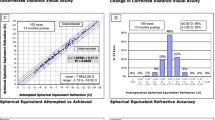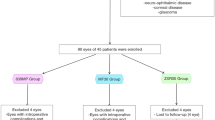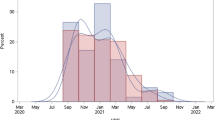Abstract
Background
This study aims to assess the long term effectiveness, safety, predictability and stability of V4c implantable collamer lenses (ICL) for correction of moderate to extreme high myopia.
Methods
We reviewed 125 eyes from 64 patients who implanted V4c ICL at the Refractive Surgery Center of West China Hospital in Chengdu, China, between May 2015 and January 2017. The median spherical equivalent was −11.50 D (interquartile range [IQR]: −13.00 to −9.00 D). We followed up with the patients over five years and evaluated several parameters, including uncorrected visual acuity (UDVA), corrected visual acuity (CDVA), axial length, refractive error, endothelial cell density (ECD), intraocular pressure (IOP), white-to-white distance (WTW), and vault. We performed a correlation analysis to explore the potential impacts on vault following implantation.
Results
The median safety index (postoperative CDVA/preoperative CDVA) during the last follow-up was 1.00 (interquartile range [IQR]: 1.00–1.20), and the efficacy indices (postoperative UDVA/preoperative CDVA) were 1.20 (IQR: 1.00–1.25), 1.20 (IQR: 1.00–1.33), and 0.8 (IQR: 0.65–1.00) at postoperative 1 week, 1 month, and 5 years, respectively. At the five-year mark, 16% of the eyes were within ±0.50 D of expected correction, and 73% were within ±2.00 D. No significant difference in ECD was observed between pre-operative and post-operative measurements. Compared to baseline, we observed a significant increase in IOP at the one-week follow-up, which decreased significantly at the one-month visit. Furthermore, we identified ICL size and spherical equivalent (SE) as independent variables in a multiple linear regression model that accurately predicted the five-year vault after surgery.
Conclusion
In conclusion, V4c ICL implantation is an effective and safe treatment for moderate to extreme high myopia with good predictability and stability over the long-term.
This is a preview of subscription content, access via your institution
Access options
Subscribe to this journal
Receive 18 print issues and online access
$259.00 per year
only $14.39 per issue
Buy this article
- Purchase on Springer Link
- Instant access to full article PDF
Prices may be subject to local taxes which are calculated during checkout




Similar content being viewed by others
Data availability
The datasets used in the current study are available from the corresponding author on reasonable request.
References
Morgan IG, French AN, Ashby RS, Guo X, Ding X, He M, et al. The epidemics of myopia: Aetiology and prevention. Prog Retin Eye Res. 2018;62:134–49.
Ang M, Gatinel D, Reinstein DZ, Mertens E, Alio Del Barrio JL, et al. Refractive surgery beyond 2020. Eye. 2021;35:362–82.
Pinero DP, Teus MA. Clinical outcomes of small-incision lenticule extraction and femtosecond laser-assisted wavefront-guided laser in situ keratomileusis. J Cataract Refract Surg. 2016;42:1078–93.
Wen D, McAlinden C, Flitcroft I, Tu R, Wang Q, Alio J, et al. Postoperative Efficacy, Predictability, Safety, and Visual Quality of Laser Corneal Refractive Surgery: A Network Meta-analysis. Am J Ophthalmol. 2017;178:65–78.
Wen D, Tu R, Flitcroft I, Wang Q, Huang Y, Song B, et al. Corneal Surface Ablation Laser Refractive Surgery for the Correction of Myopia: A Network Meta-analysis. J Refract Surg. 2018;34:726–35.
Moshirfar M, Tukan AN, Bundogji N, Liu HY, McCabe SE, Ronquillo YC, et al. Ectasia After Corneal Refractive Surgery: A Systematic Review. Ophthalmol Ther. 2021;10:753–76.
Wilson SE. Biology of keratorefractive surgery- PRK, PTK, LASIK, SMILE, inlays and other refractive procedures. Exp Eye Res. 2020;198:108136.
Igarashi A, Shimizu K, Kamiya K. Eight-year follow-up of posterior chamber phakic intraocular lens implantation for moderate to high myopia. Am J Ophthalmol. 2014;157:532–539.e531.
Packer M. Meta-analysis and review: effectiveness, safety, and central port design of the intraocular collamer lens. Clin Ophthalmol. 2016;10:1059–77.
Moya T, Javaloy J, Montes-Mico R, Beltran J, Munoz G, Montalban R. Implantable Collamer Lens for Myopia: Assessment 12 Years After Implantation. J Refract Surg. 2015;31:548–56.
Montes-Mico R, Ruiz-Mesa R, Rodriguez-Prats JL, Tana-Rivero P. Posterior-chamber phakic implantable collamer lenses with a central port: a review. Acta Ophthalmol. 2021;99:e288–e301.
Lee J, Kim Y, Park S, Bae J, Lee S, Park Y, et al. Long-term clinical results of posterior chamber phakic intraocular lens implantation to correct myopia. Clin Exp Ophthalmol. 2016;44:481–7.
Chen X, Wang X, Xu Y, Cheng M, Han T, Wang X, et al. Long-term Comparison of Vault and Complications of Implantable Collamer Lens with and without a Central Hole for High Myopia Correction: 5 Years. Curr Eye Res. 2022;47:540–6.
Ye Y, Zhao J, Niu L, Shi W, Wang X, Zhou X. Long-term evaluation of anterior lens density after implantable collamer lens V4c implantation in patients with myopia over 40 years old. Br J Ophthalmol. 2022;106:1508–13.
Shimizu K, Kamiya K, Igarashi A, Shiratani T. Early clinical outcomes of implantation of posterior chamber phakic intraocular lens with a central hole (Hole ICL) for moderate to high myopia. Br J Ophthalmol. 2012;96:409–12.
Subudhi P, Patro S, Agarwal P, Khan Z, Subudhi BNR, Mekap C, et al. Safety and Efficacy of a New Posterior Chamber Phakic Intraocular Lens in Cases of High Myopia: Early Results. Clin Ophthalmol. 2020;14:3681–9.
Yasa D, Urdem U, Agca A, Yildirim Y, Kepez Yildiz B, Kandemir Besek N, et al. Early Results with a New Posterior Chamber Phakic Intraocular Lens in Patients with High Myopia. J Ophthalmol. 2018;2018:1329874.
Kim TI, Alio Del Barrio JL, Wilkins M, Cochener B, Ang M. Refractive surgery. Lancet. 2019;393:2085–98.
Sioufi K, Zheleznyak L, MacRae S, Rocha KM. Femtosecond Lasers in Cornea & Refractive Surgery. Exp Eye Res. 2021;205:108477.
McAlinden C. Corneal refractive surgery: past to present. Clin Exp Optom. 2012;95:386–98.
Alfonso JF, Fernandez-Vega-Cueto L, Alfonso-Bartolozzi B, Montes-Mico R, Fernandez-Vega L:. Five-Year Follow-up of Correction of Myopia: Posterior Chamber Phakic Intraocular Lens With a Central Port Design. J Refract Surg. 2019;35:169–76.
Gasser L, Biermann J, Reinhard T. New posterior chamber phakic intraocular lens for high myopia: three-year results. J Cataract Refract Surg. 2015;41:1610–5.
Pinto C, Monteiro T, Franqueira N, Faria-Correia F, Mendes J, Vaz F. Posterior chamber collamer phakic intraocular lens implantation: Comparison of efficacy and safety for low and moderate-to-high myopia. Eur J Ophthalmol. 2022;32:894–901.
Alfonso JF, Lisa C, Fernandez-Vega Cueto L, Belda-Salmeron L, Madrid-Costa D, Montes-Mico R. Clinical outcomes after implantation of a posterior chamber collagen copolymer phakic intraocular lens with a central hole for myopic correction. J Cataract Refract Surg. 2013;39:915–21.
Shimizu K, Kamiya K, Igarashi A, Kobashi H. Long-Term Comparison of Posterior Chamber Phakic Intraocular Lens With and Without a Central Hole (Hole ICL and Conventional ICL) Implantation for Moderate to High Myopia and Myopic Astigmatism: Consort-Compliant Article. Medicine. 2016;95:e3270.
Du R, Xie S, Igarashi-Yokoi T, Watanabe T, Uramoto K, Takahashi H, et al. Continued Increase of Axial Length and Its Risk Factors in Adults With High Myopia. JAMA Ophthalmol. 2021;139:1096–103.
Lee MW, Lee SE, Lim HB, Kim JY. Longitudinal changes in axial length in high myopia: a 4-year prospective study. Br J Ophthalmol. 2020;104:600–3.
Ueda E, Yasuda M, Fujiwara K, Hashimoto S, Ohno-Matsui K, Hata J, et al. Trends in the Prevalence of Myopia and Myopic Maculopathy in a Japanese Population: The Hisayama Study. Invest Ophthalmol Vis Sci. 2019;60:2781–6.
Wong YL, Saw SM. Epidemiology of Pathologic Myopia in Asia and Worldwide. Asia Pac J Ophthalmol. 2016;5:394–402.
Huseynova T, Ozaki S, Ishizuka T, Mita M, Tomita M. Comparative study of 2 types of implantable collamer lenses, 1 with and 1 without a central artificial hole. Am J Ophthalmol. 2014;157:1136–43.
Wang XQ, Chen X, Xu YL, Cheng MR, Niu LL, Wang XY, et al. Long term results of central hole type posterior chamber intraocular lens in the correction of moderate to high myopia. Zhonghua Yan Ke Za Zhi. 2023;59:129–34.
Kamiya K, Shimizu K, Igarashi A, Ishikawa H. Evaluation of pupil diameter after posterior chamber phakic intraocular lens implantation. Eye. 2010;24:588–94.
Kawamorita T, Uozato H, Shimizu K. Fluid dynamics simulation of aqueous humour in a posterior-chamber phakic intraocular lens with a central perforation. Graefes Arch Clin Exp Ophthalmol. 2012;250:935–9.
Lindland A, Heger H, Kugelberg M, Zetterstrom C. Changes in vaulting of myopic and toric implantable collamer lenses in different lighting conditions. Acta Ophthalmol. 2012;90:788–91.
Garcia-De la Rosa G, Olivo-Payne A, Serna-Ojeda JC, Salazar-Ramos MS, Lichtinger A, Gomez-Bastar A, et al. Anterior segment optical coherence tomography angle and vault analysis after toric and non-toric implantable collamer lens V4c implantation in patients with high myopia. Br J Ophthalmol. 2018;102:544–8.
Zhao J, Zhao J, Yang W, Li M, Hao G, Chen Z, et al. Consecutive contralateral comparison of toric and non-toric implantable collamer lenses V4c in vault after implantation for myopia and astigmatism. Acta Ophthalmol. 2021;99:e852–e859.
Funding
This work was supported by the Science and Technology Planning Project of Sichuan Province (No.2020YFS0257; No. 2023YFS0179).
Author information
Authors and Affiliations
Contributions
QW conducted the analysis and drafted the original manuscript, while PYH, RW reviewed the relevant articles. HBY, JT, KM, and YPD developed the idea for the paper. All authors provided feedback and approved the final text.
Corresponding authors
Ethics declarations
Competing interests
The authors declare no competing interests.
Ethics approval
The research adhered to the ethical principles outlined in the Helsinki Declaration and received approval from the Ethics Committee of West China Hospital (No. 20210427).
Additional information
Publisher’s note Springer Nature remains neutral with regard to jurisdictional claims in published maps and institutional affiliations.
Supplementary information
Rights and permissions
Springer Nature or its licensor (e.g. a society or other partner) holds exclusive rights to this article under a publishing agreement with the author(s) or other rightsholder(s); author self-archiving of the accepted manuscript version of this article is solely governed by the terms of such publishing agreement and applicable law.
About this article
Cite this article
Wan, Q., He, P., Wei, R. et al. Long-term observation of V4c implantable collamer lenses implantation for moderate to extreme high myopia correction: five years follow-up. Eye (2024). https://doi.org/10.1038/s41433-024-03046-9
Received:
Revised:
Accepted:
Published:
DOI: https://doi.org/10.1038/s41433-024-03046-9



